Reflective Practice in Oncology Ward: Personal Experience and Lessons
VerifiedAdded on 2022/09/18
|15
|4313
|30
Essay
AI Summary
This essay presents a personal reflection on the author's first year as a qualified nurse in an oncology ward, focusing on the concepts of inter-professional and collaborative practice. The author details their experiences working with a team of healthcare professionals, including physicians and expert nurses, and caring for patients, including children. The essay uses Gibb's reflective model to analyze the author's feelings, evaluations, and actions during challenging situations, such as communication issues and decision-making processes within the team. The author discusses the importance of clear communication, respect, and understanding the needs of patients, highlighting the value of inter-professional collaboration in improving patient care. The reflection covers the author's transition from a student mentality to a confident and independent nurse, emphasizing the growth in skills and the significance of teamwork in the healthcare environment. The essay also touches upon the Humanistic Nursing theory and the need for holistic approaches to patient care.
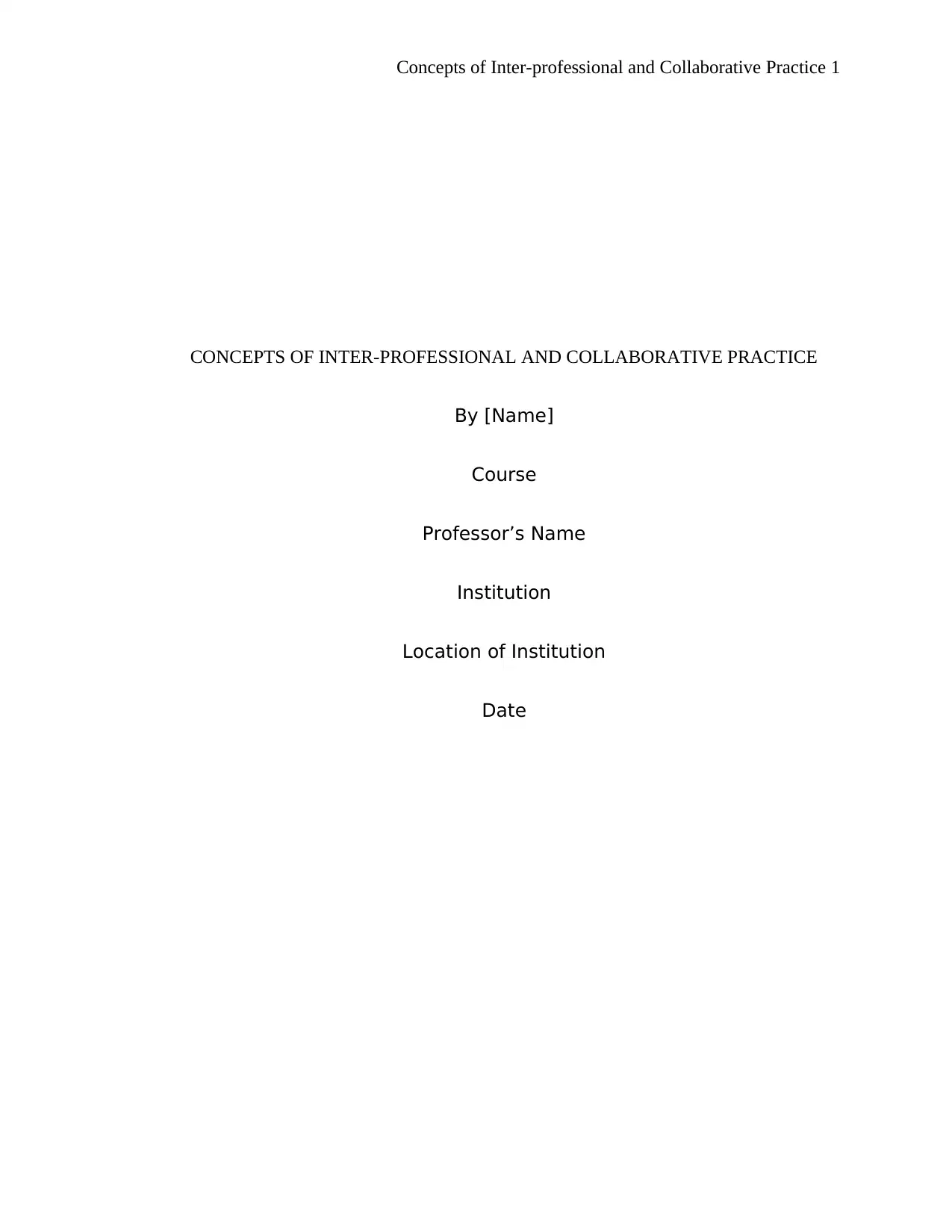
Concepts of Inter-professional and Collaborative Practice 1
CONCEPTS OF INTER-PROFESSIONAL AND COLLABORATIVE PRACTICE
By [Name]
Course
Professor’s Name
Institution
Location of Institution
Date
CONCEPTS OF INTER-PROFESSIONAL AND COLLABORATIVE PRACTICE
By [Name]
Course
Professor’s Name
Institution
Location of Institution
Date
Paraphrase This Document
Need a fresh take? Get an instant paraphrase of this document with our AI Paraphraser
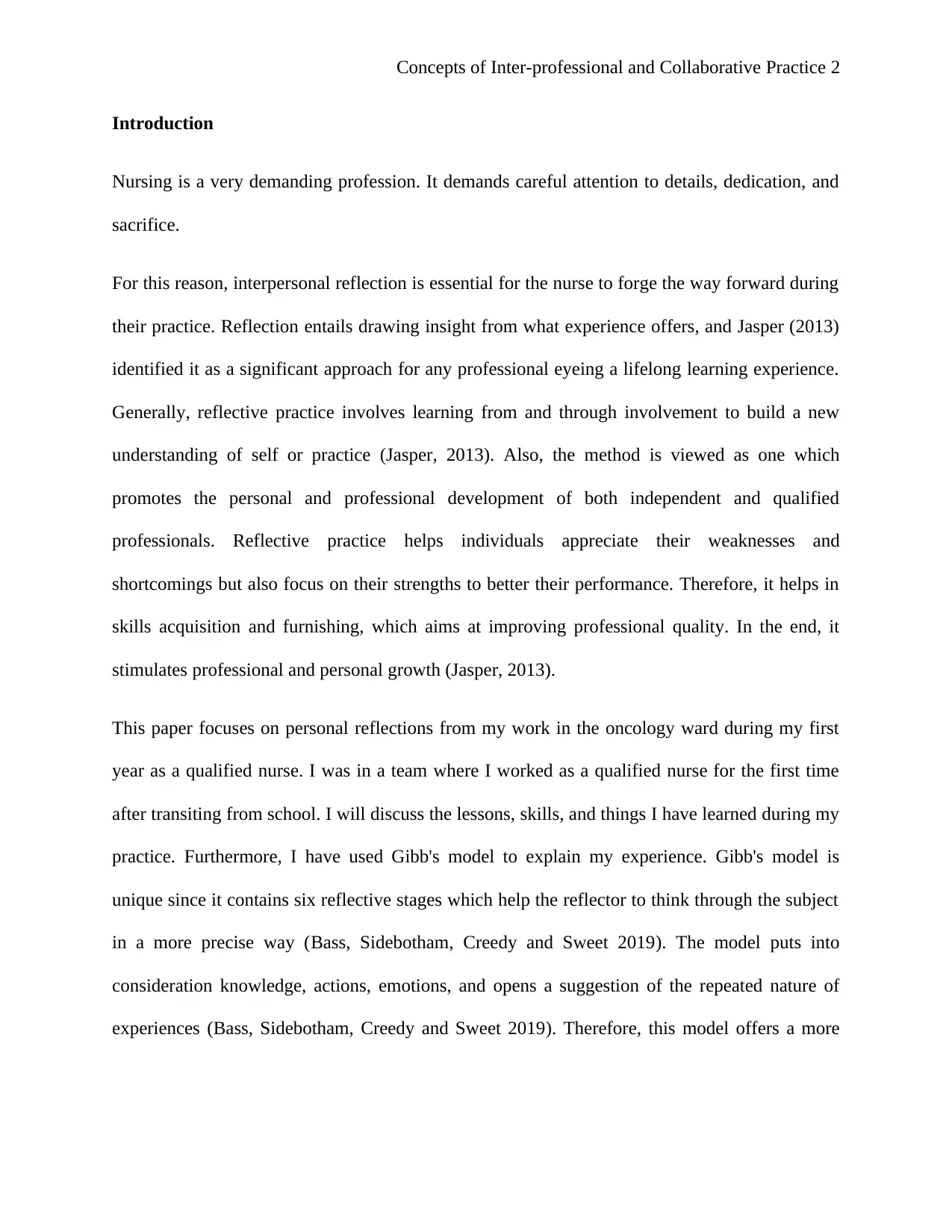
Concepts of Inter-professional and Collaborative Practice 2
Introduction
Nursing is a very demanding profession. It demands careful attention to details, dedication, and
sacrifice.
For this reason, interpersonal reflection is essential for the nurse to forge the way forward during
their practice. Reflection entails drawing insight from what experience offers, and Jasper (2013)
identified it as a significant approach for any professional eyeing a lifelong learning experience.
Generally, reflective practice involves learning from and through involvement to build a new
understanding of self or practice (Jasper, 2013). Also, the method is viewed as one which
promotes the personal and professional development of both independent and qualified
professionals. Reflective practice helps individuals appreciate their weaknesses and
shortcomings but also focus on their strengths to better their performance. Therefore, it helps in
skills acquisition and furnishing, which aims at improving professional quality. In the end, it
stimulates professional and personal growth (Jasper, 2013).
This paper focuses on personal reflections from my work in the oncology ward during my first
year as a qualified nurse. I was in a team where I worked as a qualified nurse for the first time
after transiting from school. I will discuss the lessons, skills, and things I have learned during my
practice. Furthermore, I have used Gibb's model to explain my experience. Gibb's model is
unique since it contains six reflective stages which help the reflector to think through the subject
in a more precise way (Bass, Sidebotham, Creedy and Sweet 2019). The model puts into
consideration knowledge, actions, emotions, and opens a suggestion of the repeated nature of
experiences (Bass, Sidebotham, Creedy and Sweet 2019). Therefore, this model offers a more
Introduction
Nursing is a very demanding profession. It demands careful attention to details, dedication, and
sacrifice.
For this reason, interpersonal reflection is essential for the nurse to forge the way forward during
their practice. Reflection entails drawing insight from what experience offers, and Jasper (2013)
identified it as a significant approach for any professional eyeing a lifelong learning experience.
Generally, reflective practice involves learning from and through involvement to build a new
understanding of self or practice (Jasper, 2013). Also, the method is viewed as one which
promotes the personal and professional development of both independent and qualified
professionals. Reflective practice helps individuals appreciate their weaknesses and
shortcomings but also focus on their strengths to better their performance. Therefore, it helps in
skills acquisition and furnishing, which aims at improving professional quality. In the end, it
stimulates professional and personal growth (Jasper, 2013).
This paper focuses on personal reflections from my work in the oncology ward during my first
year as a qualified nurse. I was in a team where I worked as a qualified nurse for the first time
after transiting from school. I will discuss the lessons, skills, and things I have learned during my
practice. Furthermore, I have used Gibb's model to explain my experience. Gibb's model is
unique since it contains six reflective stages which help the reflector to think through the subject
in a more precise way (Bass, Sidebotham, Creedy and Sweet 2019). The model puts into
consideration knowledge, actions, emotions, and opens a suggestion of the repeated nature of
experiences (Bass, Sidebotham, Creedy and Sweet 2019). Therefore, this model offers a more

Concepts of Inter-professional and Collaborative Practice 3
flexible and expansive way of looking into situations more particularly to bring about positive
future changes.
Description
I was assigned as a qualified nurse to work on patients in an oncology ward. In this ward, my
task was updating expert nurses with information with the patient's progress. This involved
patient recovery, reception of treatment, and give further recommendations to what could be
done next. My team comprised of experts and physicians as well as different expert nursing and
healthcare professionals from other healthcare disciplines (Howatson-Jones, 2016). Generally, I
had to do a lot of work caring and treating many children who had mental problems, some of
who were so scary to handle. These included children from the age of 10-17 years of age. In my
experience, I have learned the art of proper and clear communication with members of my team
as well as patients (Middleton 2017).
Furthermore, I have also learned the value of respect for others in the course of practice.
Admittedly, it took me so long to adapt to my new roles as a trained nurse working in that
situation. However, I have learned to use my skills also but adequately gained more skills which
became instrumental in critical situations.
During my assignment, I was disseminating reports to the appropriate departments as well as
communication strategies with the physicians. However, I realized that different personalities
within the group create different group dynamics. For instance, the way information is received
among the different people I have worked with. As a result, there was a need for self-evaluation
to ensure that I continue to do that which I am supposed to do but in a manner that is ethical and
flexible and expansive way of looking into situations more particularly to bring about positive
future changes.
Description
I was assigned as a qualified nurse to work on patients in an oncology ward. In this ward, my
task was updating expert nurses with information with the patient's progress. This involved
patient recovery, reception of treatment, and give further recommendations to what could be
done next. My team comprised of experts and physicians as well as different expert nursing and
healthcare professionals from other healthcare disciplines (Howatson-Jones, 2016). Generally, I
had to do a lot of work caring and treating many children who had mental problems, some of
who were so scary to handle. These included children from the age of 10-17 years of age. In my
experience, I have learned the art of proper and clear communication with members of my team
as well as patients (Middleton 2017).
Furthermore, I have also learned the value of respect for others in the course of practice.
Admittedly, it took me so long to adapt to my new roles as a trained nurse working in that
situation. However, I have learned to use my skills also but adequately gained more skills which
became instrumental in critical situations.
During my assignment, I was disseminating reports to the appropriate departments as well as
communication strategies with the physicians. However, I realized that different personalities
within the group create different group dynamics. For instance, the way information is received
among the different people I have worked with. As a result, there was a need for self-evaluation
to ensure that I continue to do that which I am supposed to do but in a manner that is ethical and
⊘ This is a preview!⊘
Do you want full access?
Subscribe today to unlock all pages.

Trusted by 1+ million students worldwide
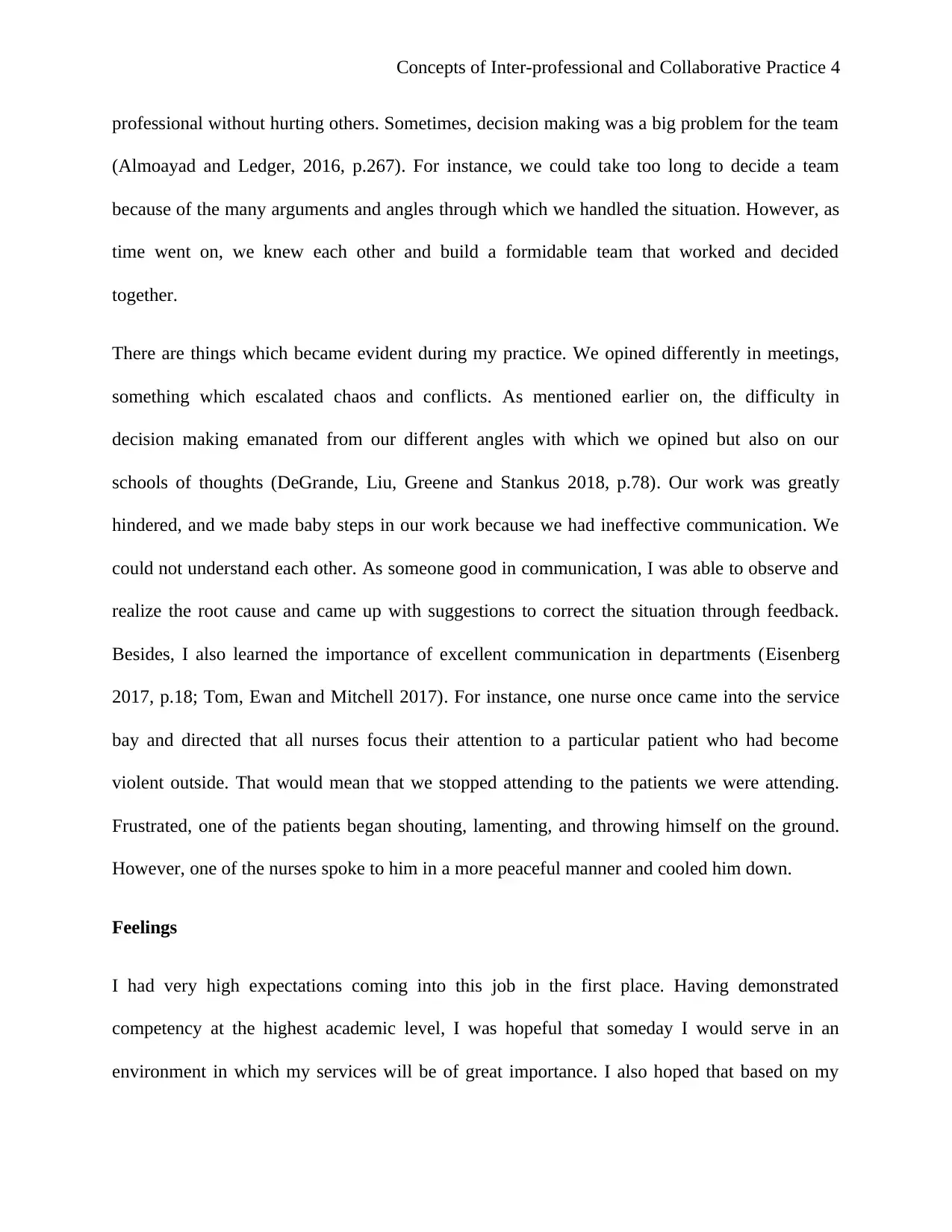
Concepts of Inter-professional and Collaborative Practice 4
professional without hurting others. Sometimes, decision making was a big problem for the team
(Almoayad and Ledger, 2016, p.267). For instance, we could take too long to decide a team
because of the many arguments and angles through which we handled the situation. However, as
time went on, we knew each other and build a formidable team that worked and decided
together.
There are things which became evident during my practice. We opined differently in meetings,
something which escalated chaos and conflicts. As mentioned earlier on, the difficulty in
decision making emanated from our different angles with which we opined but also on our
schools of thoughts (DeGrande, Liu, Greene and Stankus 2018, p.78). Our work was greatly
hindered, and we made baby steps in our work because we had ineffective communication. We
could not understand each other. As someone good in communication, I was able to observe and
realize the root cause and came up with suggestions to correct the situation through feedback.
Besides, I also learned the importance of excellent communication in departments (Eisenberg
2017, p.18; Tom, Ewan and Mitchell 2017). For instance, one nurse once came into the service
bay and directed that all nurses focus their attention to a particular patient who had become
violent outside. That would mean that we stopped attending to the patients we were attending.
Frustrated, one of the patients began shouting, lamenting, and throwing himself on the ground.
However, one of the nurses spoke to him in a more peaceful manner and cooled him down.
Feelings
I had very high expectations coming into this job in the first place. Having demonstrated
competency at the highest academic level, I was hopeful that someday I would serve in an
environment in which my services will be of great importance. I also hoped that based on my
professional without hurting others. Sometimes, decision making was a big problem for the team
(Almoayad and Ledger, 2016, p.267). For instance, we could take too long to decide a team
because of the many arguments and angles through which we handled the situation. However, as
time went on, we knew each other and build a formidable team that worked and decided
together.
There are things which became evident during my practice. We opined differently in meetings,
something which escalated chaos and conflicts. As mentioned earlier on, the difficulty in
decision making emanated from our different angles with which we opined but also on our
schools of thoughts (DeGrande, Liu, Greene and Stankus 2018, p.78). Our work was greatly
hindered, and we made baby steps in our work because we had ineffective communication. We
could not understand each other. As someone good in communication, I was able to observe and
realize the root cause and came up with suggestions to correct the situation through feedback.
Besides, I also learned the importance of excellent communication in departments (Eisenberg
2017, p.18; Tom, Ewan and Mitchell 2017). For instance, one nurse once came into the service
bay and directed that all nurses focus their attention to a particular patient who had become
violent outside. That would mean that we stopped attending to the patients we were attending.
Frustrated, one of the patients began shouting, lamenting, and throwing himself on the ground.
However, one of the nurses spoke to him in a more peaceful manner and cooled him down.
Feelings
I had very high expectations coming into this job in the first place. Having demonstrated
competency at the highest academic level, I was hopeful that someday I would serve in an
environment in which my services will be of great importance. I also hoped that based on my
Paraphrase This Document
Need a fresh take? Get an instant paraphrase of this document with our AI Paraphraser
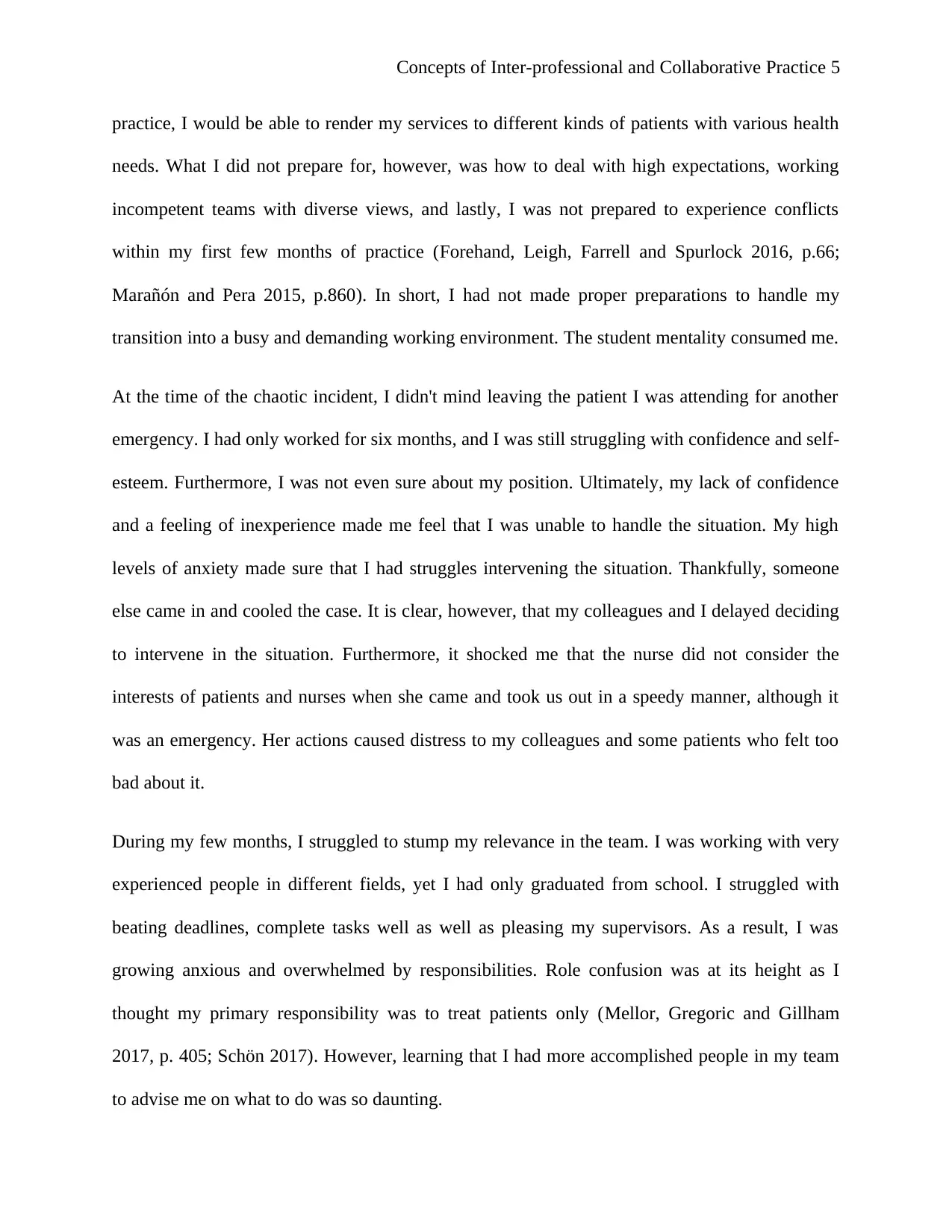
Concepts of Inter-professional and Collaborative Practice 5
practice, I would be able to render my services to different kinds of patients with various health
needs. What I did not prepare for, however, was how to deal with high expectations, working
incompetent teams with diverse views, and lastly, I was not prepared to experience conflicts
within my first few months of practice (Forehand, Leigh, Farrell and Spurlock 2016, p.66;
Marañón and Pera 2015, p.860). In short, I had not made proper preparations to handle my
transition into a busy and demanding working environment. The student mentality consumed me.
At the time of the chaotic incident, I didn't mind leaving the patient I was attending for another
emergency. I had only worked for six months, and I was still struggling with confidence and self-
esteem. Furthermore, I was not even sure about my position. Ultimately, my lack of confidence
and a feeling of inexperience made me feel that I was unable to handle the situation. My high
levels of anxiety made sure that I had struggles intervening the situation. Thankfully, someone
else came in and cooled the case. It is clear, however, that my colleagues and I delayed deciding
to intervene in the situation. Furthermore, it shocked me that the nurse did not consider the
interests of patients and nurses when she came and took us out in a speedy manner, although it
was an emergency. Her actions caused distress to my colleagues and some patients who felt too
bad about it.
During my few months, I struggled to stump my relevance in the team. I was working with very
experienced people in different fields, yet I had only graduated from school. I struggled with
beating deadlines, complete tasks well as well as pleasing my supervisors. As a result, I was
growing anxious and overwhelmed by responsibilities. Role confusion was at its height as I
thought my primary responsibility was to treat patients only (Mellor, Gregoric and Gillham
2017, p. 405; Schön 2017). However, learning that I had more accomplished people in my team
to advise me on what to do was so daunting.
practice, I would be able to render my services to different kinds of patients with various health
needs. What I did not prepare for, however, was how to deal with high expectations, working
incompetent teams with diverse views, and lastly, I was not prepared to experience conflicts
within my first few months of practice (Forehand, Leigh, Farrell and Spurlock 2016, p.66;
Marañón and Pera 2015, p.860). In short, I had not made proper preparations to handle my
transition into a busy and demanding working environment. The student mentality consumed me.
At the time of the chaotic incident, I didn't mind leaving the patient I was attending for another
emergency. I had only worked for six months, and I was still struggling with confidence and self-
esteem. Furthermore, I was not even sure about my position. Ultimately, my lack of confidence
and a feeling of inexperience made me feel that I was unable to handle the situation. My high
levels of anxiety made sure that I had struggles intervening the situation. Thankfully, someone
else came in and cooled the case. It is clear, however, that my colleagues and I delayed deciding
to intervene in the situation. Furthermore, it shocked me that the nurse did not consider the
interests of patients and nurses when she came and took us out in a speedy manner, although it
was an emergency. Her actions caused distress to my colleagues and some patients who felt too
bad about it.
During my few months, I struggled to stump my relevance in the team. I was working with very
experienced people in different fields, yet I had only graduated from school. I struggled with
beating deadlines, complete tasks well as well as pleasing my supervisors. As a result, I was
growing anxious and overwhelmed by responsibilities. Role confusion was at its height as I
thought my primary responsibility was to treat patients only (Mellor, Gregoric and Gillham
2017, p. 405; Schön 2017). However, learning that I had more accomplished people in my team
to advise me on what to do was so daunting.
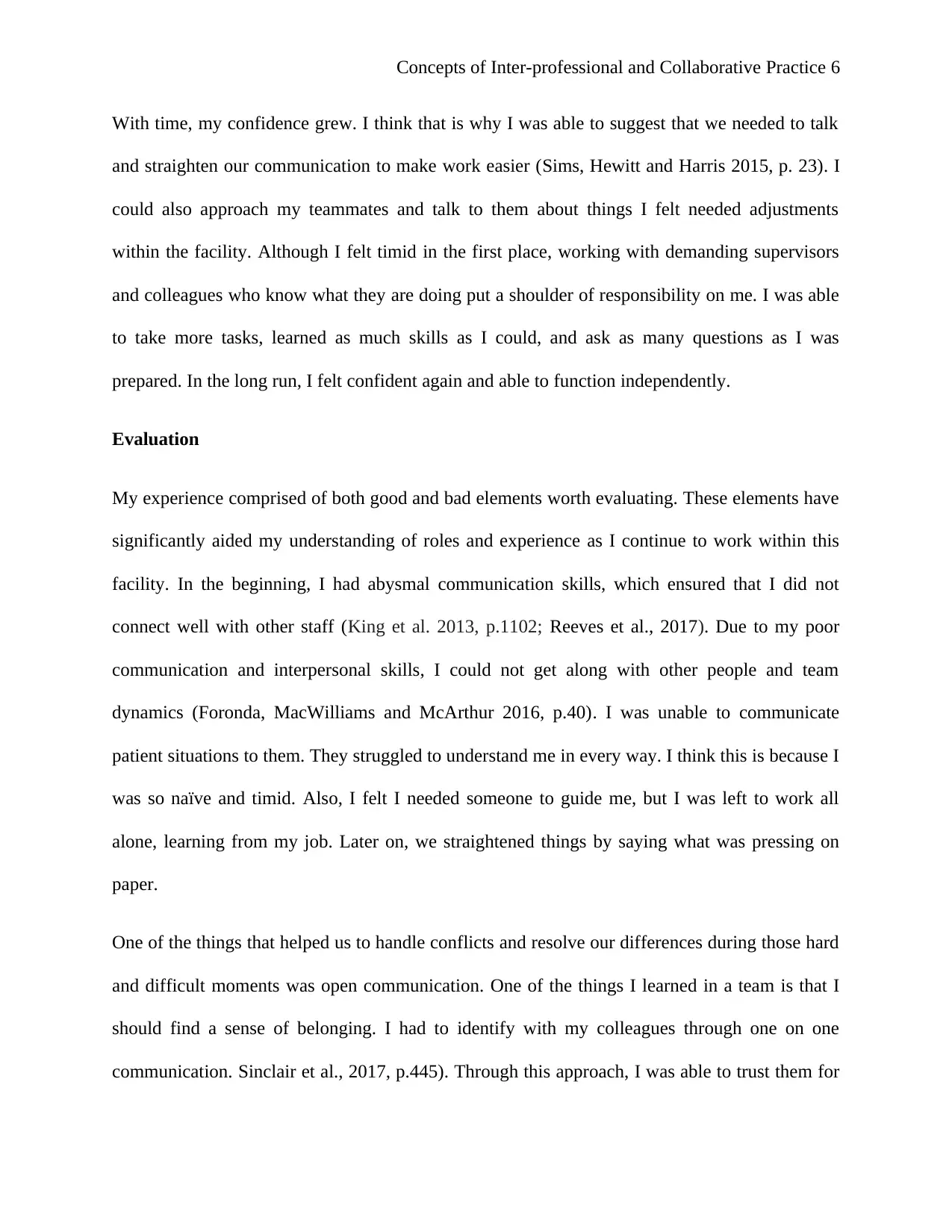
Concepts of Inter-professional and Collaborative Practice 6
With time, my confidence grew. I think that is why I was able to suggest that we needed to talk
and straighten our communication to make work easier (Sims, Hewitt and Harris 2015, p. 23). I
could also approach my teammates and talk to them about things I felt needed adjustments
within the facility. Although I felt timid in the first place, working with demanding supervisors
and colleagues who know what they are doing put a shoulder of responsibility on me. I was able
to take more tasks, learned as much skills as I could, and ask as many questions as I was
prepared. In the long run, I felt confident again and able to function independently.
Evaluation
My experience comprised of both good and bad elements worth evaluating. These elements have
significantly aided my understanding of roles and experience as I continue to work within this
facility. In the beginning, I had abysmal communication skills, which ensured that I did not
connect well with other staff (King et al. 2013, p.1102; Reeves et al., 2017). Due to my poor
communication and interpersonal skills, I could not get along with other people and team
dynamics (Foronda, MacWilliams and McArthur 2016, p.40). I was unable to communicate
patient situations to them. They struggled to understand me in every way. I think this is because I
was so naïve and timid. Also, I felt I needed someone to guide me, but I was left to work all
alone, learning from my job. Later on, we straightened things by saying what was pressing on
paper.
One of the things that helped us to handle conflicts and resolve our differences during those hard
and difficult moments was open communication. One of the things I learned in a team is that I
should find a sense of belonging. I had to identify with my colleagues through one on one
communication. Sinclair et al., 2017, p.445). Through this approach, I was able to trust them for
With time, my confidence grew. I think that is why I was able to suggest that we needed to talk
and straighten our communication to make work easier (Sims, Hewitt and Harris 2015, p. 23). I
could also approach my teammates and talk to them about things I felt needed adjustments
within the facility. Although I felt timid in the first place, working with demanding supervisors
and colleagues who know what they are doing put a shoulder of responsibility on me. I was able
to take more tasks, learned as much skills as I could, and ask as many questions as I was
prepared. In the long run, I felt confident again and able to function independently.
Evaluation
My experience comprised of both good and bad elements worth evaluating. These elements have
significantly aided my understanding of roles and experience as I continue to work within this
facility. In the beginning, I had abysmal communication skills, which ensured that I did not
connect well with other staff (King et al. 2013, p.1102; Reeves et al., 2017). Due to my poor
communication and interpersonal skills, I could not get along with other people and team
dynamics (Foronda, MacWilliams and McArthur 2016, p.40). I was unable to communicate
patient situations to them. They struggled to understand me in every way. I think this is because I
was so naïve and timid. Also, I felt I needed someone to guide me, but I was left to work all
alone, learning from my job. Later on, we straightened things by saying what was pressing on
paper.
One of the things that helped us to handle conflicts and resolve our differences during those hard
and difficult moments was open communication. One of the things I learned in a team is that I
should find a sense of belonging. I had to identify with my colleagues through one on one
communication. Sinclair et al., 2017, p.445). Through this approach, I was able to trust them for
⊘ This is a preview!⊘
Do you want full access?
Subscribe today to unlock all pages.

Trusted by 1+ million students worldwide
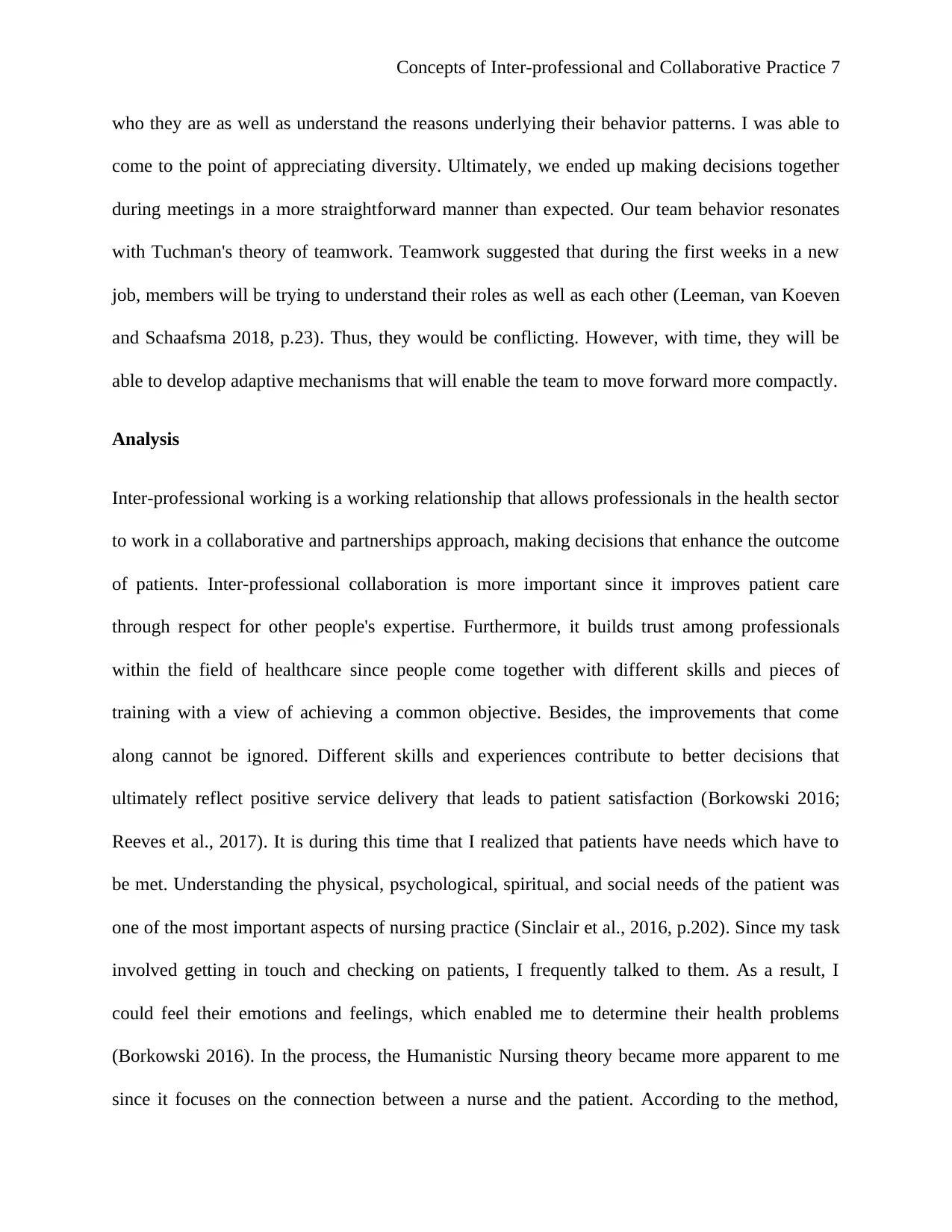
Concepts of Inter-professional and Collaborative Practice 7
who they are as well as understand the reasons underlying their behavior patterns. I was able to
come to the point of appreciating diversity. Ultimately, we ended up making decisions together
during meetings in a more straightforward manner than expected. Our team behavior resonates
with Tuchman's theory of teamwork. Teamwork suggested that during the first weeks in a new
job, members will be trying to understand their roles as well as each other (Leeman, van Koeven
and Schaafsma 2018, p.23). Thus, they would be conflicting. However, with time, they will be
able to develop adaptive mechanisms that will enable the team to move forward more compactly.
Analysis
Inter-professional working is a working relationship that allows professionals in the health sector
to work in a collaborative and partnerships approach, making decisions that enhance the outcome
of patients. Inter-professional collaboration is more important since it improves patient care
through respect for other people's expertise. Furthermore, it builds trust among professionals
within the field of healthcare since people come together with different skills and pieces of
training with a view of achieving a common objective. Besides, the improvements that come
along cannot be ignored. Different skills and experiences contribute to better decisions that
ultimately reflect positive service delivery that leads to patient satisfaction (Borkowski 2016;
Reeves et al., 2017). It is during this time that I realized that patients have needs which have to
be met. Understanding the physical, psychological, spiritual, and social needs of the patient was
one of the most important aspects of nursing practice (Sinclair et al., 2016, p.202). Since my task
involved getting in touch and checking on patients, I frequently talked to them. As a result, I
could feel their emotions and feelings, which enabled me to determine their health problems
(Borkowski 2016). In the process, the Humanistic Nursing theory became more apparent to me
since it focuses on the connection between a nurse and the patient. According to the method,
who they are as well as understand the reasons underlying their behavior patterns. I was able to
come to the point of appreciating diversity. Ultimately, we ended up making decisions together
during meetings in a more straightforward manner than expected. Our team behavior resonates
with Tuchman's theory of teamwork. Teamwork suggested that during the first weeks in a new
job, members will be trying to understand their roles as well as each other (Leeman, van Koeven
and Schaafsma 2018, p.23). Thus, they would be conflicting. However, with time, they will be
able to develop adaptive mechanisms that will enable the team to move forward more compactly.
Analysis
Inter-professional working is a working relationship that allows professionals in the health sector
to work in a collaborative and partnerships approach, making decisions that enhance the outcome
of patients. Inter-professional collaboration is more important since it improves patient care
through respect for other people's expertise. Furthermore, it builds trust among professionals
within the field of healthcare since people come together with different skills and pieces of
training with a view of achieving a common objective. Besides, the improvements that come
along cannot be ignored. Different skills and experiences contribute to better decisions that
ultimately reflect positive service delivery that leads to patient satisfaction (Borkowski 2016;
Reeves et al., 2017). It is during this time that I realized that patients have needs which have to
be met. Understanding the physical, psychological, spiritual, and social needs of the patient was
one of the most important aspects of nursing practice (Sinclair et al., 2016, p.202). Since my task
involved getting in touch and checking on patients, I frequently talked to them. As a result, I
could feel their emotions and feelings, which enabled me to determine their health problems
(Borkowski 2016). In the process, the Humanistic Nursing theory became more apparent to me
since it focuses on the connection between a nurse and the patient. According to the method,
Paraphrase This Document
Need a fresh take? Get an instant paraphrase of this document with our AI Paraphraser
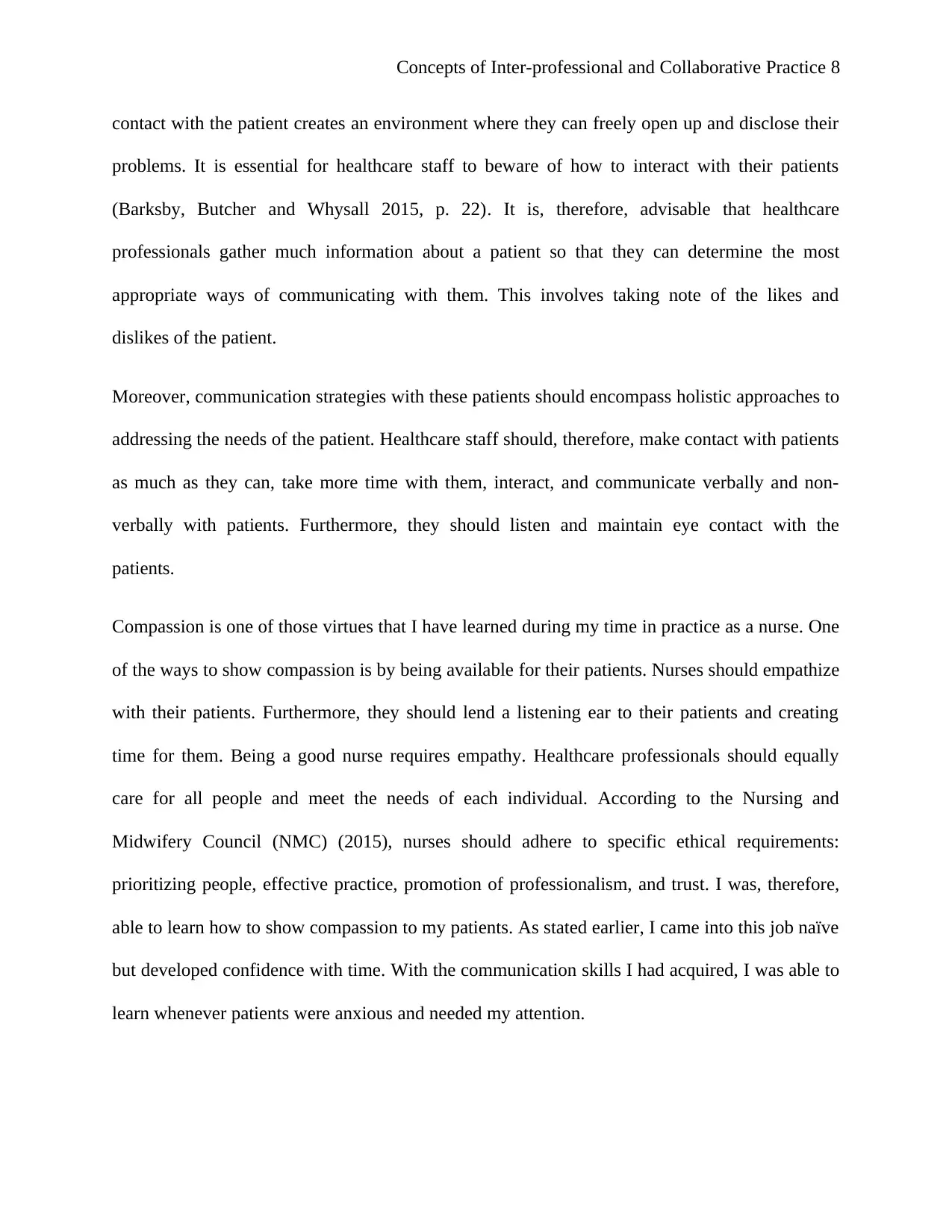
Concepts of Inter-professional and Collaborative Practice 8
contact with the patient creates an environment where they can freely open up and disclose their
problems. It is essential for healthcare staff to beware of how to interact with their patients
(Barksby, Butcher and Whysall 2015, p. 22). It is, therefore, advisable that healthcare
professionals gather much information about a patient so that they can determine the most
appropriate ways of communicating with them. This involves taking note of the likes and
dislikes of the patient.
Moreover, communication strategies with these patients should encompass holistic approaches to
addressing the needs of the patient. Healthcare staff should, therefore, make contact with patients
as much as they can, take more time with them, interact, and communicate verbally and non-
verbally with patients. Furthermore, they should listen and maintain eye contact with the
patients.
Compassion is one of those virtues that I have learned during my time in practice as a nurse. One
of the ways to show compassion is by being available for their patients. Nurses should empathize
with their patients. Furthermore, they should lend a listening ear to their patients and creating
time for them. Being a good nurse requires empathy. Healthcare professionals should equally
care for all people and meet the needs of each individual. According to the Nursing and
Midwifery Council (NMC) (2015), nurses should adhere to specific ethical requirements:
prioritizing people, effective practice, promotion of professionalism, and trust. I was, therefore,
able to learn how to show compassion to my patients. As stated earlier, I came into this job naïve
but developed confidence with time. With the communication skills I had acquired, I was able to
learn whenever patients were anxious and needed my attention.
contact with the patient creates an environment where they can freely open up and disclose their
problems. It is essential for healthcare staff to beware of how to interact with their patients
(Barksby, Butcher and Whysall 2015, p. 22). It is, therefore, advisable that healthcare
professionals gather much information about a patient so that they can determine the most
appropriate ways of communicating with them. This involves taking note of the likes and
dislikes of the patient.
Moreover, communication strategies with these patients should encompass holistic approaches to
addressing the needs of the patient. Healthcare staff should, therefore, make contact with patients
as much as they can, take more time with them, interact, and communicate verbally and non-
verbally with patients. Furthermore, they should listen and maintain eye contact with the
patients.
Compassion is one of those virtues that I have learned during my time in practice as a nurse. One
of the ways to show compassion is by being available for their patients. Nurses should empathize
with their patients. Furthermore, they should lend a listening ear to their patients and creating
time for them. Being a good nurse requires empathy. Healthcare professionals should equally
care for all people and meet the needs of each individual. According to the Nursing and
Midwifery Council (NMC) (2015), nurses should adhere to specific ethical requirements:
prioritizing people, effective practice, promotion of professionalism, and trust. I was, therefore,
able to learn how to show compassion to my patients. As stated earlier, I came into this job naïve
but developed confidence with time. With the communication skills I had acquired, I was able to
learn whenever patients were anxious and needed my attention.
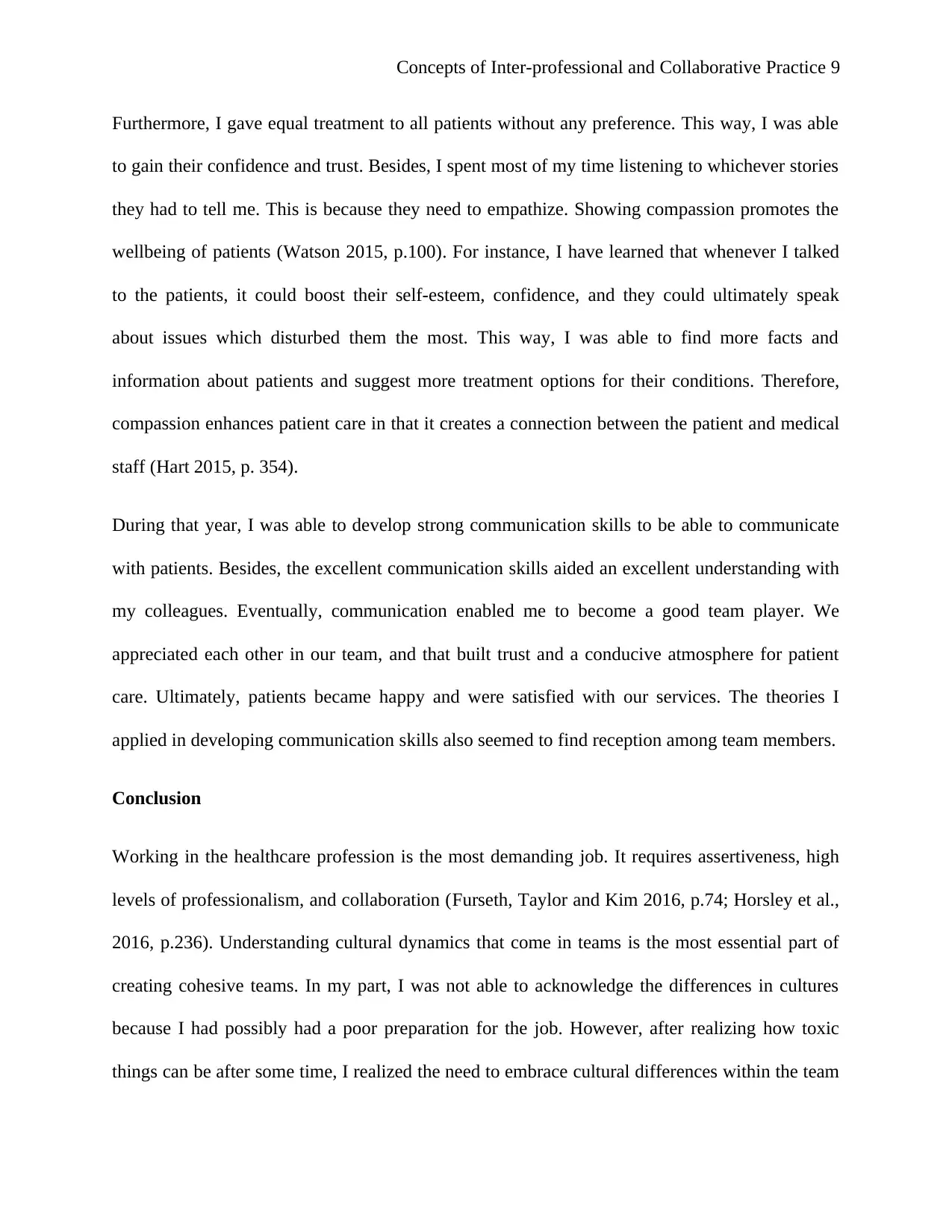
Concepts of Inter-professional and Collaborative Practice 9
Furthermore, I gave equal treatment to all patients without any preference. This way, I was able
to gain their confidence and trust. Besides, I spent most of my time listening to whichever stories
they had to tell me. This is because they need to empathize. Showing compassion promotes the
wellbeing of patients (Watson 2015, p.100). For instance, I have learned that whenever I talked
to the patients, it could boost their self-esteem, confidence, and they could ultimately speak
about issues which disturbed them the most. This way, I was able to find more facts and
information about patients and suggest more treatment options for their conditions. Therefore,
compassion enhances patient care in that it creates a connection between the patient and medical
staff (Hart 2015, p. 354).
During that year, I was able to develop strong communication skills to be able to communicate
with patients. Besides, the excellent communication skills aided an excellent understanding with
my colleagues. Eventually, communication enabled me to become a good team player. We
appreciated each other in our team, and that built trust and a conducive atmosphere for patient
care. Ultimately, patients became happy and were satisfied with our services. The theories I
applied in developing communication skills also seemed to find reception among team members.
Conclusion
Working in the healthcare profession is the most demanding job. It requires assertiveness, high
levels of professionalism, and collaboration (Furseth, Taylor and Kim 2016, p.74; Horsley et al.,
2016, p.236). Understanding cultural dynamics that come in teams is the most essential part of
creating cohesive teams. In my part, I was not able to acknowledge the differences in cultures
because I had possibly had a poor preparation for the job. However, after realizing how toxic
things can be after some time, I realized the need to embrace cultural differences within the team
Furthermore, I gave equal treatment to all patients without any preference. This way, I was able
to gain their confidence and trust. Besides, I spent most of my time listening to whichever stories
they had to tell me. This is because they need to empathize. Showing compassion promotes the
wellbeing of patients (Watson 2015, p.100). For instance, I have learned that whenever I talked
to the patients, it could boost their self-esteem, confidence, and they could ultimately speak
about issues which disturbed them the most. This way, I was able to find more facts and
information about patients and suggest more treatment options for their conditions. Therefore,
compassion enhances patient care in that it creates a connection between the patient and medical
staff (Hart 2015, p. 354).
During that year, I was able to develop strong communication skills to be able to communicate
with patients. Besides, the excellent communication skills aided an excellent understanding with
my colleagues. Eventually, communication enabled me to become a good team player. We
appreciated each other in our team, and that built trust and a conducive atmosphere for patient
care. Ultimately, patients became happy and were satisfied with our services. The theories I
applied in developing communication skills also seemed to find reception among team members.
Conclusion
Working in the healthcare profession is the most demanding job. It requires assertiveness, high
levels of professionalism, and collaboration (Furseth, Taylor and Kim 2016, p.74; Horsley et al.,
2016, p.236). Understanding cultural dynamics that come in teams is the most essential part of
creating cohesive teams. In my part, I was not able to acknowledge the differences in cultures
because I had possibly had a poor preparation for the job. However, after realizing how toxic
things can be after some time, I realized the need to embrace cultural differences within the team
⊘ This is a preview!⊘
Do you want full access?
Subscribe today to unlock all pages.

Trusted by 1+ million students worldwide
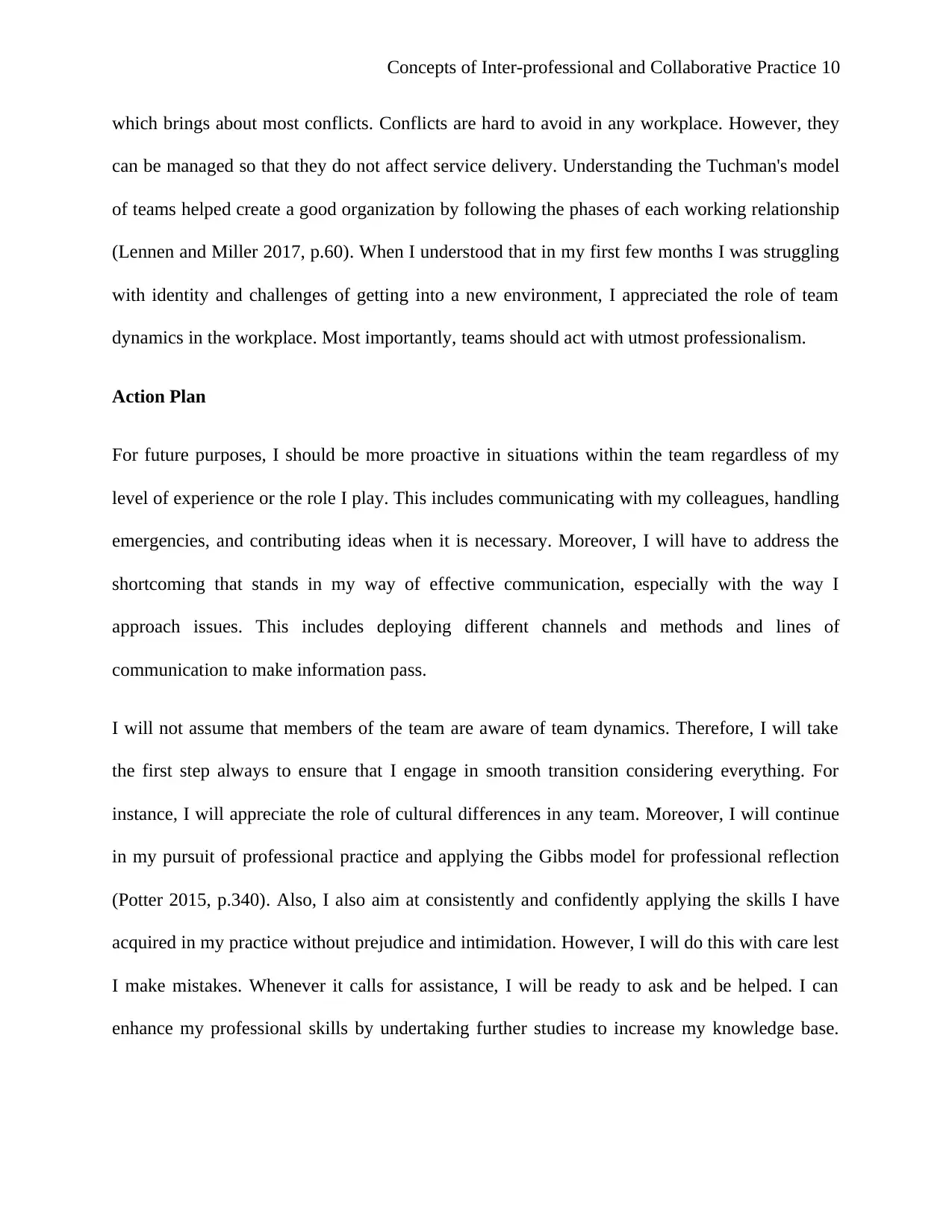
Concepts of Inter-professional and Collaborative Practice 10
which brings about most conflicts. Conflicts are hard to avoid in any workplace. However, they
can be managed so that they do not affect service delivery. Understanding the Tuchman's model
of teams helped create a good organization by following the phases of each working relationship
(Lennen and Miller 2017, p.60). When I understood that in my first few months I was struggling
with identity and challenges of getting into a new environment, I appreciated the role of team
dynamics in the workplace. Most importantly, teams should act with utmost professionalism.
Action Plan
For future purposes, I should be more proactive in situations within the team regardless of my
level of experience or the role I play. This includes communicating with my colleagues, handling
emergencies, and contributing ideas when it is necessary. Moreover, I will have to address the
shortcoming that stands in my way of effective communication, especially with the way I
approach issues. This includes deploying different channels and methods and lines of
communication to make information pass.
I will not assume that members of the team are aware of team dynamics. Therefore, I will take
the first step always to ensure that I engage in smooth transition considering everything. For
instance, I will appreciate the role of cultural differences in any team. Moreover, I will continue
in my pursuit of professional practice and applying the Gibbs model for professional reflection
(Potter 2015, p.340). Also, I also aim at consistently and confidently applying the skills I have
acquired in my practice without prejudice and intimidation. However, I will do this with care lest
I make mistakes. Whenever it calls for assistance, I will be ready to ask and be helped. I can
enhance my professional skills by undertaking further studies to increase my knowledge base.
which brings about most conflicts. Conflicts are hard to avoid in any workplace. However, they
can be managed so that they do not affect service delivery. Understanding the Tuchman's model
of teams helped create a good organization by following the phases of each working relationship
(Lennen and Miller 2017, p.60). When I understood that in my first few months I was struggling
with identity and challenges of getting into a new environment, I appreciated the role of team
dynamics in the workplace. Most importantly, teams should act with utmost professionalism.
Action Plan
For future purposes, I should be more proactive in situations within the team regardless of my
level of experience or the role I play. This includes communicating with my colleagues, handling
emergencies, and contributing ideas when it is necessary. Moreover, I will have to address the
shortcoming that stands in my way of effective communication, especially with the way I
approach issues. This includes deploying different channels and methods and lines of
communication to make information pass.
I will not assume that members of the team are aware of team dynamics. Therefore, I will take
the first step always to ensure that I engage in smooth transition considering everything. For
instance, I will appreciate the role of cultural differences in any team. Moreover, I will continue
in my pursuit of professional practice and applying the Gibbs model for professional reflection
(Potter 2015, p.340). Also, I also aim at consistently and confidently applying the skills I have
acquired in my practice without prejudice and intimidation. However, I will do this with care lest
I make mistakes. Whenever it calls for assistance, I will be ready to ask and be helped. I can
enhance my professional skills by undertaking further studies to increase my knowledge base.
Paraphrase This Document
Need a fresh take? Get an instant paraphrase of this document with our AI Paraphraser
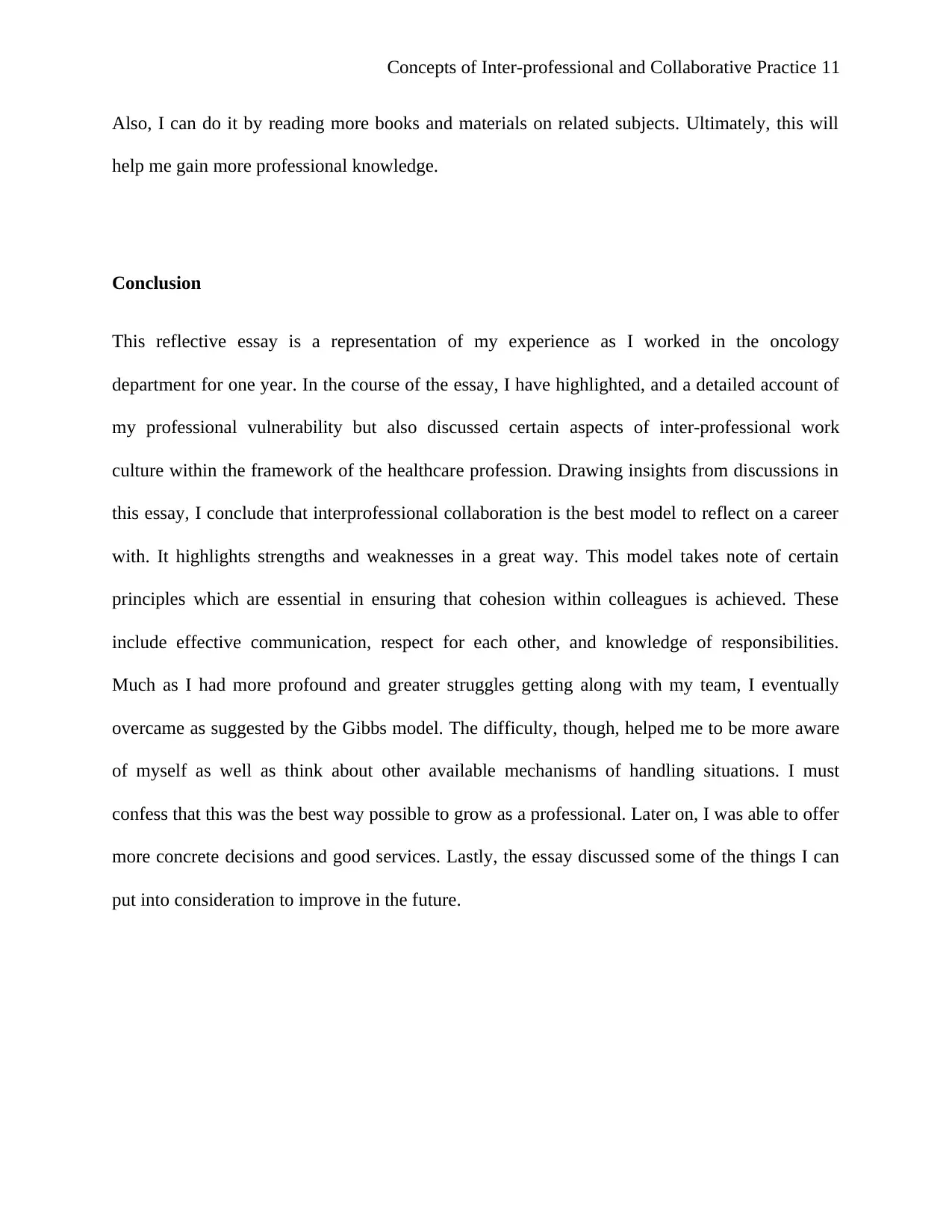
Concepts of Inter-professional and Collaborative Practice 11
Also, I can do it by reading more books and materials on related subjects. Ultimately, this will
help me gain more professional knowledge.
Conclusion
This reflective essay is a representation of my experience as I worked in the oncology
department for one year. In the course of the essay, I have highlighted, and a detailed account of
my professional vulnerability but also discussed certain aspects of inter-professional work
culture within the framework of the healthcare profession. Drawing insights from discussions in
this essay, I conclude that interprofessional collaboration is the best model to reflect on a career
with. It highlights strengths and weaknesses in a great way. This model takes note of certain
principles which are essential in ensuring that cohesion within colleagues is achieved. These
include effective communication, respect for each other, and knowledge of responsibilities.
Much as I had more profound and greater struggles getting along with my team, I eventually
overcame as suggested by the Gibbs model. The difficulty, though, helped me to be more aware
of myself as well as think about other available mechanisms of handling situations. I must
confess that this was the best way possible to grow as a professional. Later on, I was able to offer
more concrete decisions and good services. Lastly, the essay discussed some of the things I can
put into consideration to improve in the future.
Also, I can do it by reading more books and materials on related subjects. Ultimately, this will
help me gain more professional knowledge.
Conclusion
This reflective essay is a representation of my experience as I worked in the oncology
department for one year. In the course of the essay, I have highlighted, and a detailed account of
my professional vulnerability but also discussed certain aspects of inter-professional work
culture within the framework of the healthcare profession. Drawing insights from discussions in
this essay, I conclude that interprofessional collaboration is the best model to reflect on a career
with. It highlights strengths and weaknesses in a great way. This model takes note of certain
principles which are essential in ensuring that cohesion within colleagues is achieved. These
include effective communication, respect for each other, and knowledge of responsibilities.
Much as I had more profound and greater struggles getting along with my team, I eventually
overcame as suggested by the Gibbs model. The difficulty, though, helped me to be more aware
of myself as well as think about other available mechanisms of handling situations. I must
confess that this was the best way possible to grow as a professional. Later on, I was able to offer
more concrete decisions and good services. Lastly, the essay discussed some of the things I can
put into consideration to improve in the future.
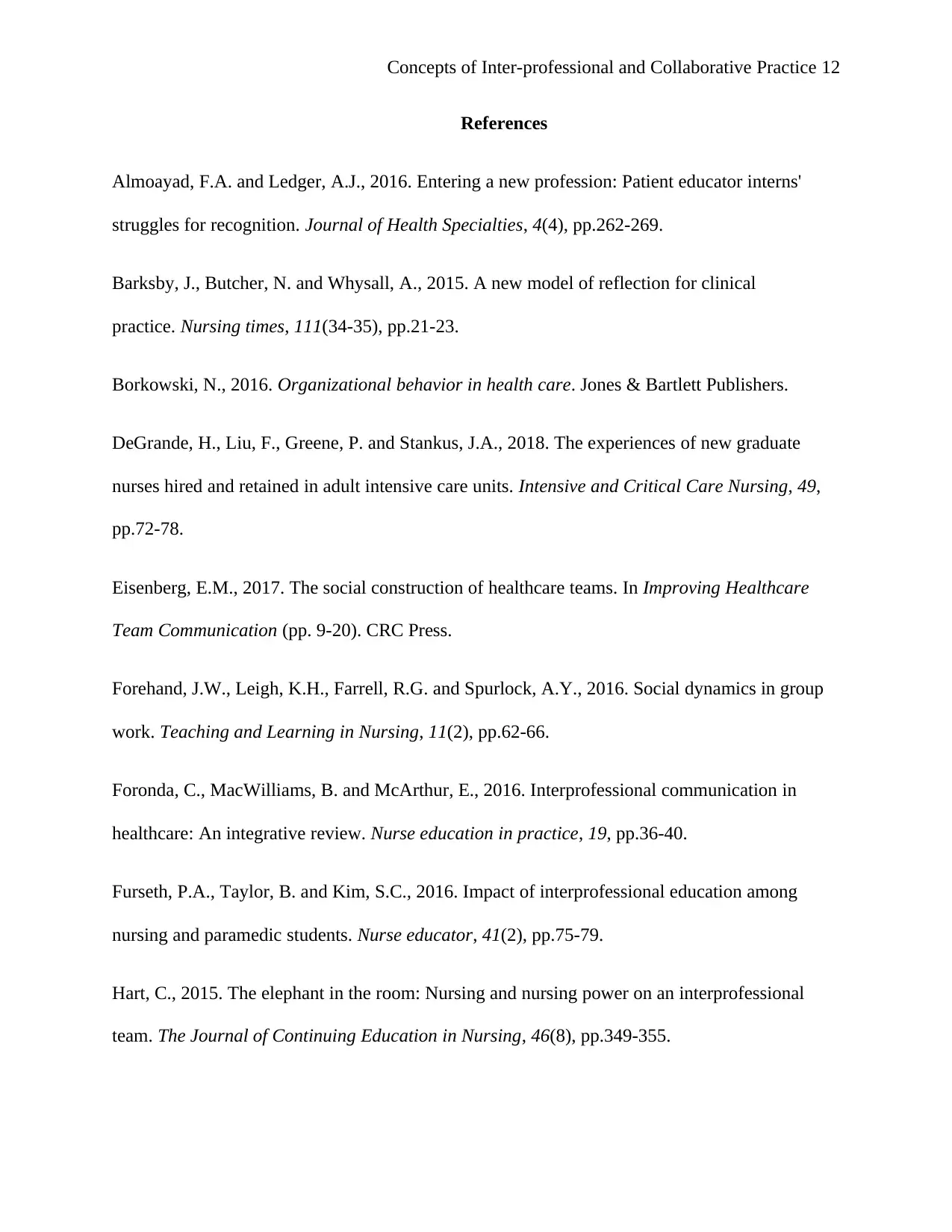
Concepts of Inter-professional and Collaborative Practice 12
References
Almoayad, F.A. and Ledger, A.J., 2016. Entering a new profession: Patient educator interns'
struggles for recognition. Journal of Health Specialties, 4(4), pp.262-269.
Barksby, J., Butcher, N. and Whysall, A., 2015. A new model of reflection for clinical
practice. Nursing times, 111(34-35), pp.21-23.
Borkowski, N., 2016. Organizational behavior in health care. Jones & Bartlett Publishers.
DeGrande, H., Liu, F., Greene, P. and Stankus, J.A., 2018. The experiences of new graduate
nurses hired and retained in adult intensive care units. Intensive and Critical Care Nursing, 49,
pp.72-78.
Eisenberg, E.M., 2017. The social construction of healthcare teams. In Improving Healthcare
Team Communication (pp. 9-20). CRC Press.
Forehand, J.W., Leigh, K.H., Farrell, R.G. and Spurlock, A.Y., 2016. Social dynamics in group
work. Teaching and Learning in Nursing, 11(2), pp.62-66.
Foronda, C., MacWilliams, B. and McArthur, E., 2016. Interprofessional communication in
healthcare: An integrative review. Nurse education in practice, 19, pp.36-40.
Furseth, P.A., Taylor, B. and Kim, S.C., 2016. Impact of interprofessional education among
nursing and paramedic students. Nurse educator, 41(2), pp.75-79.
Hart, C., 2015. The elephant in the room: Nursing and nursing power on an interprofessional
team. The Journal of Continuing Education in Nursing, 46(8), pp.349-355.
References
Almoayad, F.A. and Ledger, A.J., 2016. Entering a new profession: Patient educator interns'
struggles for recognition. Journal of Health Specialties, 4(4), pp.262-269.
Barksby, J., Butcher, N. and Whysall, A., 2015. A new model of reflection for clinical
practice. Nursing times, 111(34-35), pp.21-23.
Borkowski, N., 2016. Organizational behavior in health care. Jones & Bartlett Publishers.
DeGrande, H., Liu, F., Greene, P. and Stankus, J.A., 2018. The experiences of new graduate
nurses hired and retained in adult intensive care units. Intensive and Critical Care Nursing, 49,
pp.72-78.
Eisenberg, E.M., 2017. The social construction of healthcare teams. In Improving Healthcare
Team Communication (pp. 9-20). CRC Press.
Forehand, J.W., Leigh, K.H., Farrell, R.G. and Spurlock, A.Y., 2016. Social dynamics in group
work. Teaching and Learning in Nursing, 11(2), pp.62-66.
Foronda, C., MacWilliams, B. and McArthur, E., 2016. Interprofessional communication in
healthcare: An integrative review. Nurse education in practice, 19, pp.36-40.
Furseth, P.A., Taylor, B. and Kim, S.C., 2016. Impact of interprofessional education among
nursing and paramedic students. Nurse educator, 41(2), pp.75-79.
Hart, C., 2015. The elephant in the room: Nursing and nursing power on an interprofessional
team. The Journal of Continuing Education in Nursing, 46(8), pp.349-355.
⊘ This is a preview!⊘
Do you want full access?
Subscribe today to unlock all pages.

Trusted by 1+ million students worldwide
1 out of 15